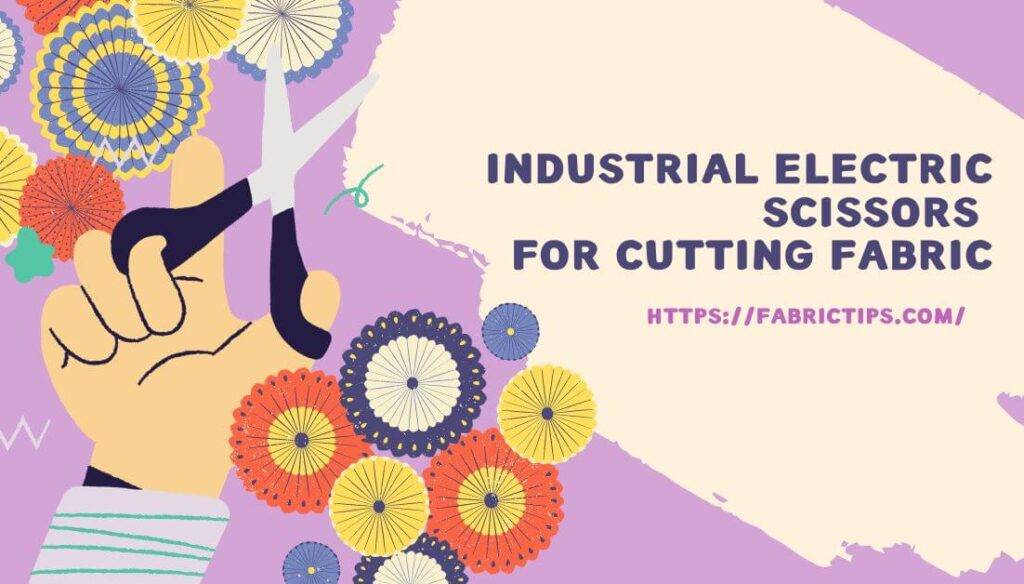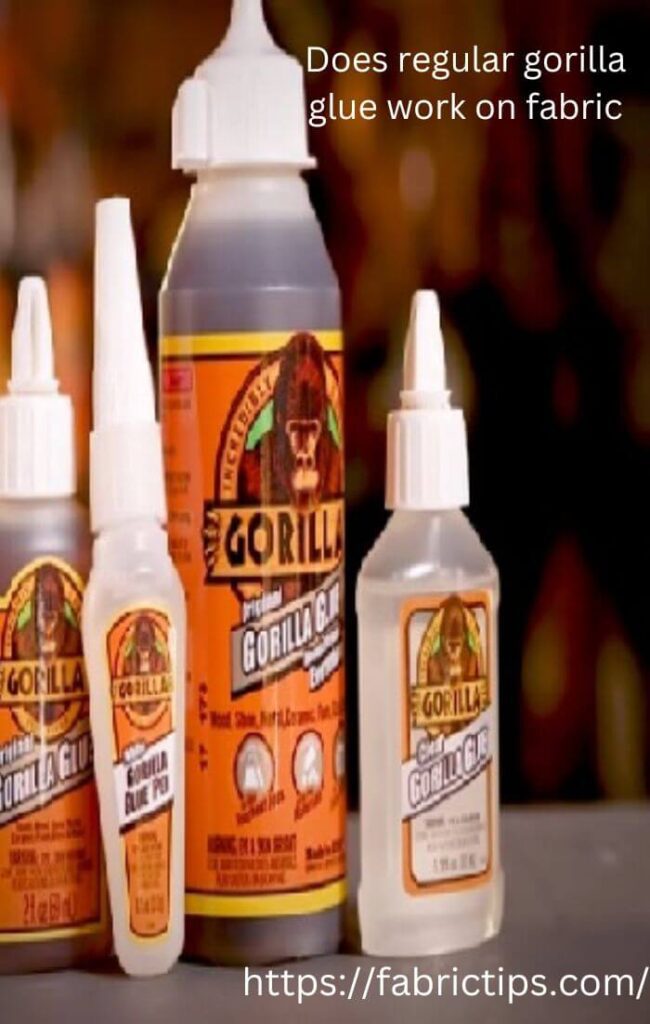Last Updated on September 20, 2023 by Wahid
Invest in a heavy-duty sewing machine to take your sewing projects to a higher level. Although a regular sewing machine works well for most jobs, some projects and textiles require a more powerful sewing machine.
The heavy-duty machines can stitch through leather and denim with no problem, regardless of how thick the fabric is. Looking for the best sewing machine for thick fabric? Hence, you are in the right place.
Heavy-duty sewing machines represent a large investment, so research your options before choosing a product. Below you’ll find a roundup of our favorite options.
5 Best Sewing Machine For Thick Fabric [What’s The Suitable One]
1. SINGER Heavy Duty 4423 Sewing Machine
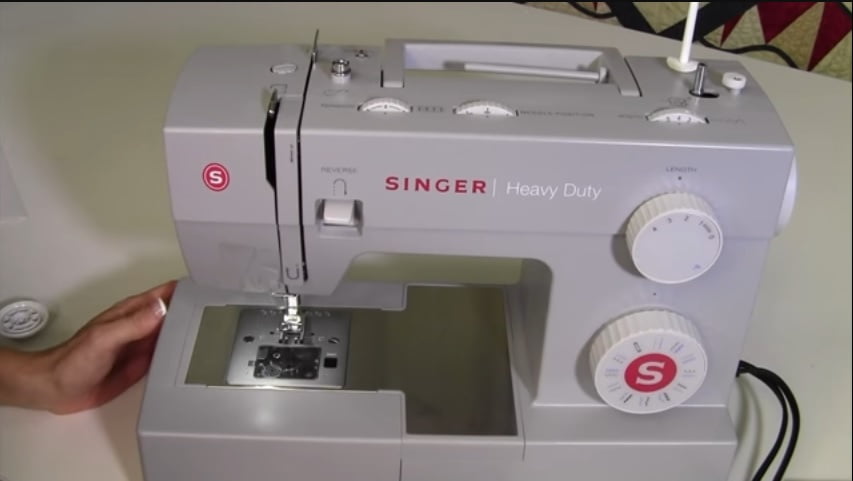
Specifications :
Type: Mechanical
Built-in Stitches: 23
Speed: 1100 Stitches Per Minute
Noise Level: 71.4 dB
Stitch Length x Stitch Width: 4 mm x 6 mm
Descriptions :
In the top spot, Singer’s powerful sewing machine has a smooth gray profile. Featuring 23 built-in stitches, it’s great for challenging sewing projects.
The Singer 4423 sewing machine offers an impressive selection of basic stitches as well as decorative stitches. Best home sewing machine for thick fabrics? In addition, this heavy-duty machine is ideal for creating buttonholes for various home decor & craft projects. Wigs, for instance, can also be made on this unit.
This tool might seem like for experts, but beginners can use it to sew thick fabrics when basic techniques are followed.
Furthermore, this tool enhances productivity by distributing between 1 and 100 stitches a minute. The built-in speed control prevents you from repeating or redoing stitches due to contingent sewing errors.
Features :
- Its best feature is its robust motor, roughly 60% stronger than most top-performing quilting machines.
- Heavyweight fabrics such as denim and canvas are usually not sewn on old sewing machines.
- The Singer allows you to pierce thicker fabrics with exceptional power. A strong motor deserves all the credit.
- Based on our customer feedback analysis, the frames appear heavy-duty metal, according to the company.
- Additionally, this durable tool ensures maximum stability; hence, you can rely on it for years to come.
- Finally, you will receive several accessories, including a zipper foot, heavy-duty needles, a button foot, lint brush, extra spool pin, bobbin, clearance plate, seam ripper, etc. Singer sewing machines are undoubtedly great value for money at this price!
Pros :
- Perfect for heavyweight sewing fabrics or complicated tasks with utility stitches
- Despite its metal frame, it’s lightweight, making it easy to move and store
- Effortless speed control with the adjustable pressure foot
- The fabric glides effortlessly over stainless steel bedplates
- The buttonhole foot makes button placement consistent in one step
- Eye fatigue is avoided with a needle threader
- Feature of reverse stitching
- To quilt free motion or by button, the teeth can be lowered
Cons :
- It’s noisy
Get it Now from Amazon
2. Brother ST371HD Sewing Machine
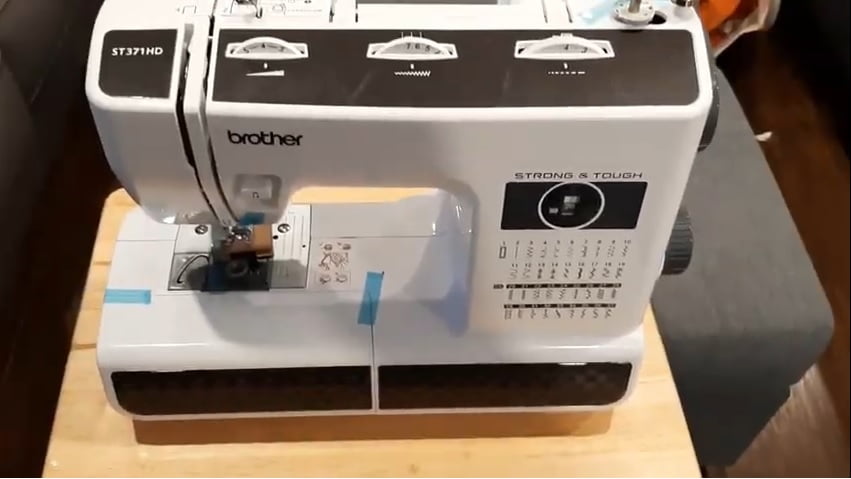
Specifications :
Speed: 800 SPM
Stitch width: 7 mm
Stitches Number: 37
Weight: 14.3 lbs
Warranty: 25 years limited
Descriptions :
Using the best Brother sewing machine for thicker fabrics will not have to worry about weak needle plate buttonholes or inconsistency.
Aside from 37 built-in stitches, this budget-friendly sewing machine also features an automatically sized buttonhole. In this way, you get uniformly spaced buttonholes.
Additionally, the variety of stitching lengths allows for various designs and improvements.
Whenever you feel overwhelmed by the number of stitches, the instructional DVD can help you decipher them precisely. Drop-in bobbins reduce jamming and securely hold the fabric to avoid sewing mistakes.
As a consequence, the fabric is held flat during feeding by the machine. Using the 800 stitches per minute sewing speed along with free-motion sewing, almost no mistakes are made instead of effortlessly completing your task.
Features :
- When running through thick fabrics, needle plates often break on sewing machines.
- Featuring high-density needles, the needle plates are strong enough to handle thicker fabrics and daily sewing projects.
- Whatever your skill level, straightforward instructions and various stitching methods will help you succeed.
- It also features auto-threading that feeds thread seamlessly into the needle.
- The machine also comes with six sewing feet, including a spring-action zigzag foot, a nonstick foot, an invisible stitch foot, a buttonhole foot, and a buttonhole foot as well.
- Well, it’s cheaper compared to the singer machine, but its efficiency and quality are commendable.
Pros :
- Due to convenience, sewing speeds can be slowed
- For beginners, it is extremely user-friendly
- Fabric can be held firmly by the presser feet
- Ensures stable stitch quality with automatic needle threader
- A total of 37 stitches, including buttonholes, blind hems, stretch stitches, and more
- Easy to store
- Price is affordable
Cons :
- Doesn’t work perfectly with other needles except for Brother
Get it Now from Amazon
3. Juki TL-2010Q 1-Needle, Lockstitch, Portable Sewing Machine
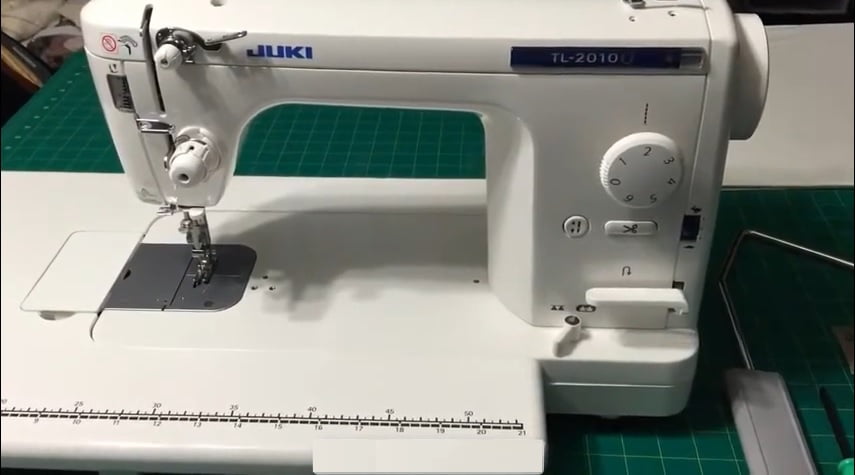
Specifications :
Type: Mechanical
Weight: 38lbs
Stitch length: 6mm
Speed: 1500 stitches per minute
Warranty: 5-year limited
Descriptions :
The Juki TL-2010 portable sewing machine makes no shrill noise, making it an ideal option for you.
Aluminum is a durable material, that’s why Juki distributes best sewing machines for thick fabric that are sturdy & long-lasting. Whether sewing canvas or denim, the Juki TK-2010 can handle any sewing task. Moreover, this quilting machine’s sewing bed and arm are die-cast aluminum. As a result, it works well for intense tasks like repairing denim jeans or creating ones from scratch.
This thread tension scale can also be used to monitor thread tension. Essentially, this feature balances tension based on threads and materials. Besides being portable, you can carry it anywhere without putting extra effort into it.
Finally, the automatic thread function cuts the thread instantly. When you slowly remove a thread loop from a needle’s back, it is easy to thread it and does not strain your eyes.
Features :
- A Juki industrial style foot controller & trim button are used here. As a result, sewing speed and trimming can be controlled perfectly.
- With this sewing machine, you can easily sew home decor, large quilts, & other intricate projects.
- In addition, it features innovative features like the subtension system, adjustable speed slider, LED indicator, etc., to ensure precision sewing.
- Additionally, you will have a 23-inch extension table that gives you the ability to handle large & heavy fabrics.
- Juki TL-2010 portable sewing machine also features a foot-operated trimming system for trimming top as well as bobbin threads.
- In this case, you don’t need to worry about button sewing on the sewing machine. The button sew-on foot engages a zig-zag stitch, placing the button in minutes.
Pros :
- Sewing in free motion with accuracy
- Stitch speed of 1500 per minute
- Aluminum construction makes it durable
- Presser-foot extends up to 12mm
- Suitable for quilting & utility stitches
- Speed can be balanced with the presser-foot control
- Using a speed control device, sewing tasks can be performed at a low speed
Cons :
- Having trouble threading the bobbin
Get it Now from Amazon
4. Janome Industrial-Grade Aluminum-Body HD1000 Black
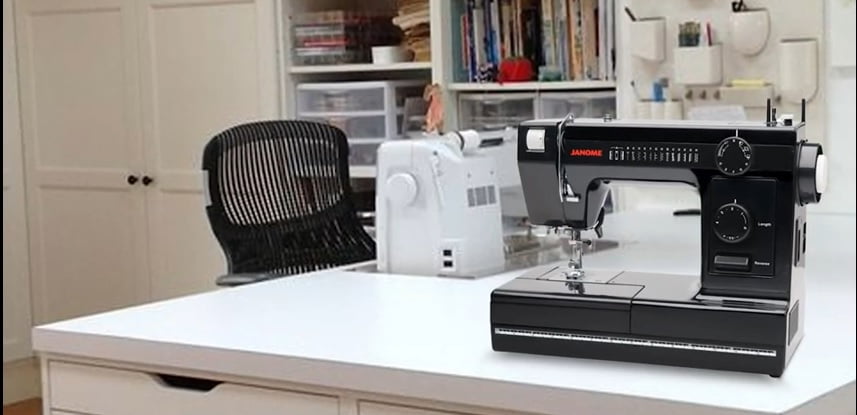
Specifications :
Type: Mechanic
Stitch Length: 4mm
Stitch Width: 5mm
Speed: 840 stitches per minute
Weight: 8lbs
Warranty: 25 years limited
Descriptions :
Looking for sewing machine for heavy fabric? Yes, it doesn’t fit the decor & homey ambiance. However, if you own a Janome industrial-grade sewing machine, it won’t matter how it looks. The sleek black color of this powerful sewing machine blends in with your room’s decor.
In addition, the materials used in its construction are industrial-grade, so that they will last. Aside from that, it’s not complicated to handle this Janome sewing machine. As a result of its ease of use, it can be used even by novice sewers. Thus, it’s very popular among beginners.
Additionally, since it features a blind hem foot, blind hems can easily be achieved by following the instructions. No need to worry bout what is the best sewing machine for heavy fabrics? As a whole, this machine is capable of sewing thick & heavy fabrics such as nylon webbings and Ellen Griswold costumes.
There’s more to the sewing machine, including a free arm that can be removed to sew up small openings.
Features :
- Regarding the bobbin, Janome HD1000 has a front loading bobbin with 14 stitches and four-step buttonholes, as well as stitch width and length adjustment capacity.
- In contrast to the Janome HD3000, it is much heavier and easier to transport.
- Its sturdy steel interior frames ensure stability during serious sewing.
- Furthermore, you’ll receive advanced accessories such as 4 presser feet, needles, a hardcover, and a bobbin.
- Moreover, the machine offers free-motion sewing capabilities with a three-part feed dog.
- Lastly, let’s discuss the powerful motor that handles a wide range of fabrics & sewing tasks. Also, it has 1500 stitches per minute speed capacity.
Pros :
- The metal interior frame sewing machine is powerful
- Sleeves & pants can be hemmed with this tool
- Noise-free performance
- High-speed movement prevents wobbling
- Simple to use
- Stylish appearance and convenient storage
Cons :
- Speed dial is not available
Get it Now from Amazon
5. JUKI TL-2000Qi Sewing And Quilting Machine
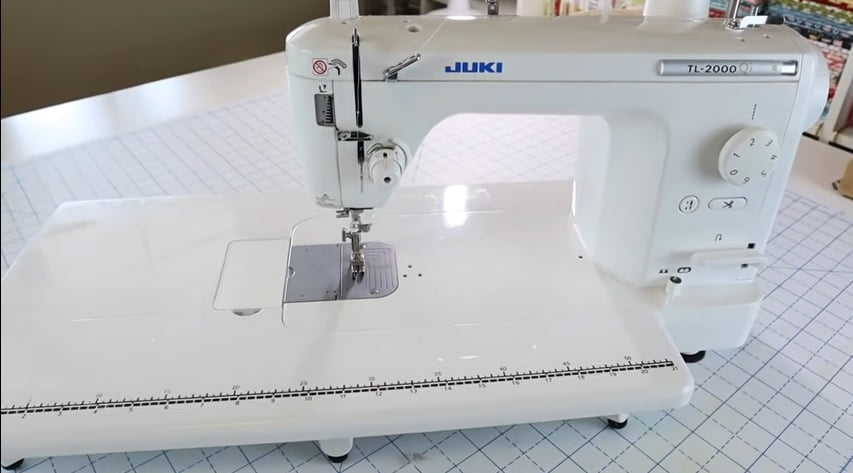
Specifications :
Type: Mechanical
Built-in stitches: only straight stitches
Speed: 1500 stitches per minute
Stitch length: 6mm
Stitch width: not specified
Weight: 4 lbs
Warranty: 2/5 year
Descriptions :
Here is another creation by the Jukis. Its extension table can hold a bigger quilt than the TL 2000qi. Providing a large working area makes it an ideal sewing machine to handle complicated tasks.
Also, a needle threader can assist you with threading the needle. Using the foot pedal here, you can adjust the speed with utmost manual ease.
One pedal functions like the gas pedal on your vehicle. Pressing the button increases the speed intensity.
You generate more speed when you exert a downward force. In conclusion, it’s a budget-friendly machine for beginner sewers unwilling to sacrifice quality.
Features :
- First, the pricing differs between Juki TL 2000 QI & 2010 QI.
- It weighs the same as the 2010 QI, although it costs far less.
- Additionally, the device can distribute up to 1500 amps of power for high-power quilting jobs and decor.
- In this way, this sewing machine will also be used to sew nylon webbing.
- Normally, sewing machines of this speed will wobble or vibrate, but this one provides vibration-free sewing tasks.
Pros :
- The maximum stitch length is 6mm
- Operation is vibration-free
- Extending table included
- Suitable for straight stitching
- An LED light increases productivity
- An excellent price
Cons :
- The bobbin does not work properly
Get it Now from Amazon
What Is The Best Way To Sew Thick Fabric With A Sewing Machine? [Answered]

Surely you have already selected the sewing machine you prefer to use for thick sewing fabrics. What is the best process for thick sewing fabric using a sewing machine?
Though typical sewing isn’t a problem, sewing through heavy fabrics like denim, fake fur, vinyl, and leather can be daunting.
Our only 6 steps are the easiest & most effective way to accomplish this task. Let’s examine the steps below to simplify the entire process!
Step 1: Trim Your Seam Allowance
If your fabric layers already have a seam, ensure that you check them before you start sewing. When seams are already stitched, open the seams and minimize seam allowances to reduce the bulk.
Step 2: Choose An Appropriate Needle
A needle is essential to any sewing project, especially when working with thick fabrics. Because of this, you must select a needle that can withstand extreme tension & cut through thick layers. Denim needles in sizes 90 and 100 are recommended.
Step 3: Setting Up The Machine
The thick fabrics need to be stitched together using an appropriate machine setting. It is necessary to lengthen the stitch here a bit. However, topstitching increases stitch length from 3.5mm to 4.5mm.
Step 4: Stitching
Although many stitchers use the pedal for stitching, we recommend using the handwheel. It is more convenient & performs the job perfectly. Typically, if the fabric you’re working on is relatively thick and does not have enough space, a handwheel is better than a pedal.
Step 5: Don’t Forget The Wedge
Perfect sewing is based on the presser foot’s ideal qualities. Sewing the first stitch will be difficult if you don’t know what you’re doing. Level the presser foot appropriately now to ensure rightness.
A scrap of fabric should be folded to be equal in thickness to the sewing project. When you’re done, slide it under your presser foot until you level it appropriately.
Step 6: Use Special Feet If Necessary
It’s not mandatory to use special feet, but it can make your task easier. Walking feet or roller feet can be used. Walking feet are almost a must-have best sewing machine for heavy duty fabrics for leather, allowing for quick and easy movement between layers of fabric. Alternatively, roller feet can be used to stitch over sticky fabrics like faux leather.
BEST SEWING MACHINE FOR THICK FABRICS: BUYING GUIDE
If you’re a beginner, how will you decide on the best sewing machine? Well, regardless of whether you are looking for sewing machines to sew knitted fabrics or backpacking gear, you will need some guidance. Therefore, here is a quick buying guide that explains what you should consider before buying sewing machines.
A Machine’s Type
Sewing machines are classified into electronic, mechanical, and computerized types. There are a variety of specialties among them all.
In recent years, electronic and computerized sewing machines have become more popular for their speed and ease of use. In particular, if you work with thick fabrics & need multiple stitch styles, electronic sewing machines are handy.
Sewing machines made of metal or plastic offer their own advantages, such as user-friendliness, adaptability, low cost, and suitability for beginners.
To sew utility stitches, you will need an old-fashioned stitching machine, such as the “Singer 4423,” to accomplish the task.
Type Of Sewing
You should decide what kind of sewing you are going to do, such as decorative items, heavy-duty denim, leather, etc., before you purchase a sewing machine. Additionally, it is important to take into account whether you will sew layers of the fabric regularly or just occasionally.
A Singer 4423, for example, can sew both light & bulky fabrics. Conversely, “Janome and Brother” tend to work best with thick fabrics such as leather or small openings and hems & sleeves. These openings are best handled by commercial sewing machines.
Working Spaces
Furthermore, make sure you check the sewing machine’s working space, which is also known as the space around the needle as well as the structure. When you work with large materials, you should have a throat plate that is wide & extended.
In contrast, if you are working on small sewing projects, you might do better when using a narrow sewing plate. “The brother ST371HD” sewing machine features a wide extension table and a free arm, thus allowing it to handle both narrow and wide quilts.
Sewing Style, Width, & Stitch Length
Having a sewing machine that offers a variety of sewing styles makes it more versatile. If you have a lot of sewing styles built-in, you can experiment with various sewing operations.
As an example, Singer 4423 sewing machines feature 23 built-in stitch styles for increased idealness and compatibility.
In general, the stitch length on sewing machines varies from “0mm to 5mm.” By investing more, you will have a wider variety of stitch lengths available. Typically, manually operated sewing machines lack the ability to adjust stitch lengths. The walking foot is often not included as well.
Speed And Tension Adjustment
Finally, make sure to adjust the tension of the thread to control its rigidity. By adjusting this, you can decide whether or not the fabric should be held tight. However, be careful not to hold it too tightly to avoid puckered fabrics. Also, make sure your grip is not so loose that it rips the stitches.
If you prefer faster stitching speeds, buy a heavy-duty machine. In the case of “the Singer, 1100 stitches” can be produced in a minute. It is easier for beginners to control sewing machine for all fabrics when sewing at a slower speed.
Frequently Asked Questions
01. A Heavy-Duty Sewing Machine Is Worth The Investment, Right?
Sewing machines that are heavy-duty are commonly used in the industry. Additionally, they can sew much faster than standard sewing machines since they can handle a wide range of fabrics. Obviously, not every person needs a machine that can handle heavy sewing.
02. How Should I Tense Thick Fabrics?
If your upholstery fabric is thick, choose upholstery thread and a sharp 18/110 or 16/100 needle. When sewing canvas or denim, use heavy-duty thread and denim needles 90/14.
03. My Machine Isn’t Sewing Thick Fabrics. Why?
When your machine balks at stitching thicker materials, raise the presser foot with a wedge so that the seam can be started. At the beginning of your seam, this will lift the fabric a little. Haberdashery stores also sell wedges, which are usually rubber and plastic the material.
04. Do Sewing Machines Have The Ability To Handle Thick Materials?
Avoid pushing fabrics larger than 6 mm (approximately 1/4 inch) deep through your machine. Consequently, the needle may break & cause injury.
The needle size should be larger when sewing thick fabrics. Combination of thread, fabric, & needle as well.
05. Are Regular Sewing Machines Capable Of Handling Heavy Fabrics?
Sewing thick & tough materials are possible with some machines. However, you should only use 1 if it’s clearly stated by the machine’s manufacturer in its features.
Check if your household machine is constructed or designed like an industrial one. “Juki,” as an example, makes household sewing machines using its industrial and advanced sewing machine technologies.
06. When Sewing Thick Fabrics, How Should You Proceed?
Ensure that the sewing machine is powerful and suitable enough to handle thick materials.
- The entire fabric layer should go underneath the presser foot.
- Sewing materials should be sewn with the appropriate needle & thread size.
- Make sure your sewing machine is set up correctly, and test it on a scrap of fabric.
- Rather than pins, use clips to hold thick fabrics.
- Feed the fabric smoothly with a walking foot.
- Reduce bulk by working slowly and trimming seam allowances afterward.
07. Stitching Thick Fabric: What Is The Best Stitch?
Sewing thick fabrics require a long vertical stitch. The stitch length should be set to around 4.5, but try it on a scrap piece of heavy material sewing machine.
In addition, lockstitching the seams will help prevent unraveling. For unsightly stitches, adjust the tension of the sewing machine after each side is equal.
08. How Do Heavy Duty & Industrial Sewing Machines Differ?
The purpose of industrial machines is to handle heavier workloads, long-running and dealing with more intensive projects compared to domestic machines. You will need to use your sewing machine constantly if you are passionate about sewing, so opt for an industrial machine.
09. Why Do We Need Heavy Duty Sewing Machines?
As the name implies, heavy-duty sewing machines have the capability of sewing heavy materials. Its sturdy construction allows it to work with thick & tough materials. Due to its motor, it is also capable of sewing quickly even when the textile layers are challenging.
If you want to sew canvas, denim, leather, and outdoor and sports materials, you’ll need a sturdy sewing machine. Moreover, it can handle heavy sewing accessories, needles, & threads, in contrast to ordinary domestic machines.
10. When Sewing Thick Fabric, Why Do My Stitches Skip?
Whenever you sew through too many layers or too thick a fabric at the same time, your stitches may skip. This may be due to your needle’s inability to penetrate completely. To avoid too many layers, sew slowly and use an extended stitch length.
The Final Word
Thanks for reading our review of the best sewing machine for thick fabrics. We hope you find it helpful. Here is our personal recommendation for the best sewing machine if you’re looking for speed and ease of use.
In contrast, if you’re looking for more stitching styles, the Brother sewing machine offers 37 built-in stitches. Currently, to hold larger quilts and fabrics, we trust Juki’s creations. As for the power of the motor and the convenience of buttonholes, we trust Janome.
Thus, you need to pick one that meets all your requirements and seems to be your best option.

